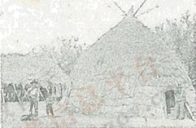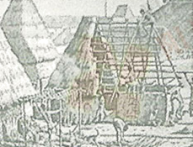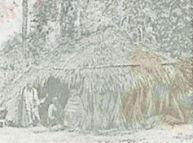| IN CONTEXT BRANCH Geology BEFORE 6th century BCE The Greek thinker Thales of Miletus notes magnetic rocks, or lodestones (天然磁石). 1st century CE Chinese diviners make primitive compasses with iron spoon that can turn around to point south. 1269 French scholar Pierre de Maricourt sets out the basic laws of magnetic attraction, repulsion, and poles. AFTER 1824 French mathematician Siméon Poisson models the forces in a magnetic field. 1940s American physicist Walter Maurice Elsasser attributes Earth’s magnetic field to iron swirling in its outer core as the planet rotates. 1958 Explorer 1 space mission shows Earth’s magnetic field extending far out into space. | By the late 1500s, ships’ captains already relied on magnetic compasses to maintain their course across the oceans. Yet no one knew how they worked. Some thought the compass needle was attracted to the North Star, others that it was drawn to magnetic mountains in the Arctic. It was English physician William Gilbert who discovered that Earth itself is magnetic. Stronger reasons are obtained from sure experiments and demonstrated arguments than from probable conjectures (推测) and the opinions of philosophical speculators. William GilbertGilbert’s breakthrough came not from a flash of inspiration, but from 17 years of careful experiment. He learned all he could from ships’ captains and compass makers, and then he made a model globe, or “terrella,” out of the magnetic rock lodestone and tested compass needles against it. The needles reacted around the terrella just as ships’ compasses did on a larger scale—showing the same patterns of declination (pointing slightly away from true north at the geographic pole, which differs from magnetic north) and inclination (tilting down from the horizontal toward the globe). Gilbert concluded, rightly, that the entire planet is a magnet and has a core of iron. He published his ideas in the book De Magnete (On the Magnet) in 1600, causing a sensation. Johannes Kepler and Galileo, in particular, were inspired by his suggestion that Earth is not fixed to rotating celestial spheres, as most people still thought, but is made to spin by the invisible force of its own magnetism. |
| A.The North Star navigated their ships. |
| B.The magnetic mountains in the Arctic guided their journey. |
| C.Magnetic compasses helped them maintain the course. |
| D.The forces in a magnetic field attracted the ships. |
| A.Through trials and errors. |
| B.Through some personal philosophical speculation. |
| C.By acquiring some flash inspiration. |
| D.By studying the ideas of some philosophers. |
| A.The earth stays still. |
| B.Gilbert successfully refuted the laws of magnetic attraction. |
| C.Gilbert’s findings and conclusions are sensational. |
| D.The earth has its own magnetic field. |
相似题推荐
【推荐1】You cannot see any object unless light from that object gets into your eyes. Some of the things you see give off: light of their own. The sun, the stars, a lighted lamp are examples that can be seen by their own light. Such things are luminous. Most of the things you see are not giving off light of their own. They are simply reflecting light that falls on them from the sun or some other luminous bodies. The moon, for example, does not give off any light of its own. It is non-luminous. You see it because sunlight falls on it and some of it reflects in our direction. So moon light is only second hand sunlight.
When you look at a book, it sends to your eyes some of the light which falls on it, and you see the book. If light could be kept out from where you are so that there would be no light for the book to reflect, then you could not see the book even with your eyes wide open.
Light travels so fast that the time in which it travels from the book you are reading to your eyes is so short as if there were no time at all. Light reaches us from the moon, which is about 380 000 kilometers away, in only a little more than a second.
1. The underlined word “luminous” means________ .| A.visible |
| B.giving off light |
| C.all colors |
| D.sunlight |
| A.your eyes are close to it |
| B.it has light of its own |
| C.it reflects some of the light |
| D.your eyesight can get to it |
| A.All the things you can see give off light. |
| B.Light from the book is much shorter than that from the moon. |
| C.Light travels so fast that there is no time for you to read. |
| D.The moment you open your eyes the light from the book travels to your eyes. |
【推荐2】Roller coasters are fast and exciting. But passing a painful kidney (肾) stone is not. The process is painful and can take a long time. But American researchers have found that a roller coaster ride just might help those suffering from a kidney stone. They say such rides help patients pass the stones with a 70 percent success rate.
David Wartinger led the study. He found that where the person sits on the roller coaster can make a big difference. He said, “In the pilot study, sitting in the last car of the roller coaster showed about a 64 percent success rate, while sitting in the first few cars only had a 16 percent success rate.”
When it comes to passing kidney stones, not all roller coasters are equal. The researchers used 174 kidney stones of different shapes, sizes and weights to see if each model worked on the same ride and on two other roller coasters. They found that Big Thunder Mountain was the only one that worked. The other two roller coasters both failed the test. Wartinger said the other rides were too fast and too violent. The movement forced the stones against the side of the kidney. He said that the ideal roller coaster is rough and quick with some twists and turns.
It also mattered where the stones were located in the kidney. The researchers found that stones located in the upper part of the kidney model were passed 100 percent.
Wartinger thinks roller coaster rides could really be used as an effective measure. He said that a yearly ride on a roller coaster could even prevent stones from developing. “You need to heed the warnings before going on a roller coaster,” he said “If you have a kidney stone, but are otherwise healthy and meet the requirements of the ride, you can absolutely try it.”
He adds that it’s definitely a lower cost alternative to other treatments. And riding a roller coaster is definitely more interesting!
1. What might passing kidney stones be like?| A.quick. |
| B.exciting. |
| C.enjoyable. |
| D.uncomfortable. |
| A.Sitting in the first car of a roller coaster. |
| B.The stone forced against the side of the kidney. |
| C.The stone located in the lower part of the kidney. |
| D.Riding rough and fast roller coasters with twists and turns. |
| A.It can prevent the development of kidney stones. |
| B.It can help anyone besides those with kidney stones. |
| C.It can prevent danger because of its effective warning. |
| D.It can apply to everyone with kidney stones effectively. |
| A.Concerned. | B.Disapproving. |
| C.Favorable. | D.Doubtful. |
【推荐3】Exciting concertos (协奏曲) from Vivaldi’s The Four Seasons can boost mental alertness, according to research from Northumbria University.
The findings, which are published in Experimental Psychology, show that the exciting first movement, in particular, is capable of enhancing attention and memory.
In the experiment a group of 14 young adults were given a mental concentration task to perform. They were asked to press the space bar on a keyboard when a green square appeared on screen and ignore different colored circles and squares that appeared at intervals. The participants carried out this task both in silence and while listening to each of the four concertos while their brain activity was measured using EEG brain imaging.
Results showed that participants responded correctly faster when listening to the exciting Spring concerto. When listening to the concerto, the average response time in performing the task was 393.8 millisecond as opposed to 408.1 milliseconds when the task was carried out in silence. This response time rose to 413.3 milliseconds when they listened to the slower and sadder Autumn music, therefore showing a decrease in mental capacity.
Psychologist Dr. Leigh Riby said, “The Spring movement enhanced overall activity within the brain but had an exaggerated effect on the area of the brain that’s important for emotional processing. It seemed to give rise to particular imagery in the brain and evoke positive, contented feelings which translated into higher levels of cognitive functioning.”
Dr. Riby suggests that the Spring movement is particularly special and could be used in therapy and is, in fact, quite a familiar piece to most people as it has been used successfully in marketing to induce mood and influence behavior.
He also found that the key in which the music was written had no impact on brain performance. While the Spring concerto, which is written in a major key enhanced cognitive function, the Autumn movement, which is also written in a major key, did not.
He added, “This experiment shows that cognitive capacity is enhanced when pleasant and arousing stimuli are introduced.”
1. What do we know about the research from Northumbria University?| A.It was conducted in four different seasons of a year. |
| B.It showed music can boost mental alertness. |
| C.It was done by a group of 14 young adults. |
| D.The results of the research have been published. |
| A.When they were in complete silence. |
| B.When they were listening to slow and sad music. |
| C.When they were listening to the Autumn concerto. |
| D.When they were listening to the Spring concerto. |
| A.It has been used in therapy settings. |
| B.It has been successfully used in marketing. |
| C.People think it quite special and classic. |
| D.People usually listen to it to adjust their mood. |
| A.The key in which the music was written was never important. |
| B.The Spring and the Autumn movement were written in different keys. |
| C.Pleasant and arousing stimuli can enhance cognitive capacity. |
| D.The Autumn concerto could enhance cognitive ability. |
In the eastern United States, one of the existing types was that commonly know under the Algonkian name of wigwam in which the Iroquois Indians lived. The wigwams were of wagon-top shape with straight sides and ends, made by bending young trees to form the round shape. Over this shape pieces of tree bark were laid to protect the Indians from bad weather. Over the bark dried grass was added. A small hole allowed smoke to escape from the top. Doorways at each end served also as windows. The Iroquois Indians built trunk walls all around their villages. The wall had only one opening. They could quickly close this cpening if their enemies came near.
Interestingly, the Choctaw Indians in Mississippi also lived in a wigwam of a most primitive (原始的) construction, but different from those of the Iroquois Indians. The Choctaw Indians’wigwams, made from mud,cane and straw, were in the form of a bee-hive. The covering was made of a long, tough grass. A post in the centre supported the roof. A hole in the top admitted the light, and allowed the smoke to pass out.
The tipi tent-housing of the upper lake and plains area was put up with poles set lightly in the ground, tied together near the top, and covered with bark and grass in the lake country. It was easily portable, and two women could set it up or take it down within an hour.
The Pawnee, Mandan and other Indian tribes (部落) along the Missouri built solid ring-shaped structhures of trunk, covered with earth and dried grass,housing adozen families.
The Wichita and other tribes of the Texas border built large ring-shaped houses covered with dried grass.
Apart from the regular housing, almost every tribe had some style of housing.
1. Which of the follwing pictures shows the house for the Iroquois Indians?
A. | B. |
C. | D. |
| A.with openings in the trunk walls | B.large enough for several families |
| C.in a ring shape with bark and mud | D.by bending young trees to form the shape |
| A.of the same shape | B.covered with grass |
| C.built with a post in the centre | D.built with doorways at each end |
| A.all the native Indians built trunk walls all around their houses |
| B.all the native Indian houses were built with poles tied together |
| C.the Iroquois Indians took safety into account while building their wigwams |
| D.the Choctaw Indians in Mississippi built their wigwams with straight sides and ends |
【推荐2】Technology usually keeps us away from nature. But now it is offering us an opportunity to listen to non-humans in powerful ways, connecting us again to the natural world.
Around the animal kingdom, there are sounds hard for us to decipher. Elephants, for example, communicate with each other using infra-sound (次声波), a sound frequently far below our human hearing range. Coral in the ocean also communicates with each other through sound waves. This is a shocking fact as coral doesn’t have any ears! So scientists have placed listening devices in these environments to pick up sounds humans are normally unable to detect.
After the sounds are recorded, AI (人工智能) is then able to determine their meaning. There are now whole databases of whale songs and honeybee dances. One day this information may be turned into “a zoological version of google translate”. One animal language is that of the elephant. Elephants have a different signal for honeybee, which is a threat, and a different signal for human. Moreover, they range between threatening humans and non-threatening humans.
And this technology is more powerful than that. For example, bees use dances to communicate with their peers where to go in search of nectar (花蜜). A research team in Germany, therefore, insert the bee language from AI database system into a robot bee, allowing the robot to create a dance routine that can tell the bees which direction to move. Whereas in the past, language creation had been limited to mainly apes (类人猿), with many examples of chimpanzees having been taught sign language to communicate with humans. This new technology now allows humans to socialize with different animals throughout the animal kingdom.
1. Which of the following best explains “decipher” underlined in Paragraph 2?| A.Take control. | B.Recognize. |
| C.Raise interest. | D.Communicate. |
| A.Record animal sounds as many as possible. |
| B.Work with google to translate animal signals. |
| C.Find the difference between animal and human signals. |
| D.Analyze what animal signal information indicate. |
| A.Because it uses a robot bee to find nectar. |
| B.Because it teaches chimpanzees sign language. |
| C.Because it enlarges humans’ communication with animals. |
| D.Because it helps humans discover more animal species. |
| A.AI helps humans communicate more with animals. |
| B.Animals can chat as well as humans do. |
| C.Different animals have different chatting abilities. |
| D.AI is the most powerful technology at present. |
【推荐3】Children need to be prepared for an earthquake as much as adults, if not more.
Infants and Toddlers (初学走路的儿童) For infants and toddlers, special emphasis should be placed on making their environment as safe as possible. The beds should be placed away from windows and tall bookcases that could slide or fall. A minimum of a 72-hour supply of extra water, bottles, food, juices, clothing and medications should be stored where it is most likely to be reached after an earthquake. Also keep an extra bag with these things in your car. Install bumper pads (防撞垫) to protect babies during the shaking. Install latches (闩锁) on all cupboards (not just those young children can reach) so that nothing can fall on your baby during a quake.
Preschool and School-age Children By age three or so, children can understand what an earthquake is and how to get ready for one. Take the time to explain what causes earthquakes in terms they understand. Include your children in family discussions and planning for earthquake safety. Conduct drills and review safety procedures every six months. Show children the safest places to be in each room when an earthquake hits. Also show them all possible exits from each room. Teach children what to do wherever they are during an earthquake (at school, in a tall building, outdoors). Make sure children’s emergency cards at school are up-to-date. It’s important that they know what gas smells like. Advise children to tell an adult if they smell gas after an earthquake.
1. What kind of people does the passage aim at?| A.Children | B.Adults | C.Students | D.Parents |
| A.Placing the bed away from windows. | B.Explaining the causes of an earthquake. |
| C.Showing children the safest places. | D.Pointing the exits of each room to them. |
| A.run away | B.tell an adult |
| C.hide in the safe place | D.look for the exits |



